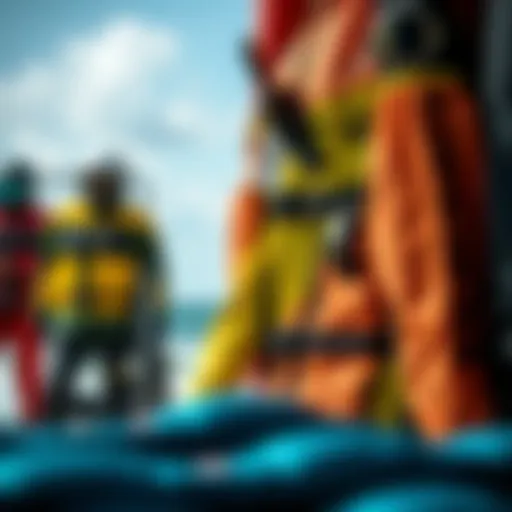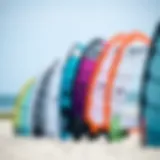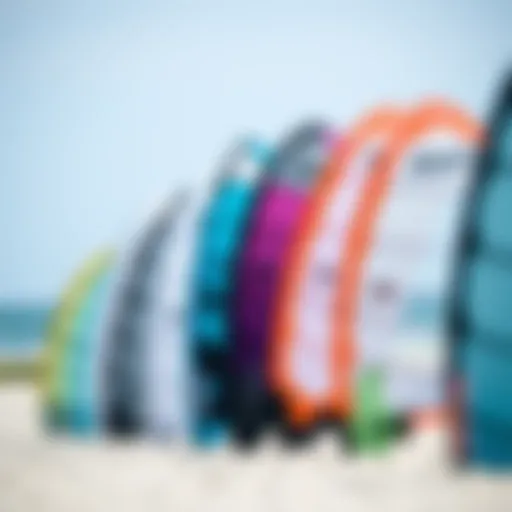Exploring Wing Sailing: The Future of Water Sports


Intro
Wing sailing is producing quite a buzz in the water sports community, snapping the attention of kiteboarders and sailors alike. This innovative approach cleverly juggles elements from various disciplines like kiteboarding and windsurfing while introducing its unique twist. As the sport picks up momentum, enthusiasts are scratching their heads, seeking to understand the ins and outs of wing sailing.
Imagine soaring over sparkling waters, harnessing the wind's power with a beautifully designed wing in tow. The thrill of gliding, maneuvering, and catching some air is not just a fantasy; it lies ahead for those willing to dive into this captivating new realm.
To better appreciate the thrilling pastime of wing sailing, this article will explore key techniques that seasoned kiteboarders can carry over into their new practice. We'll also take a dig into essential equipment you'll need, analyze popular spots for wing sailing, and discuss safety considerations for maximizing enjoyable experiences on the water. With every wave, the possibilities are endless, awaiting those who dare to experiment and soar.
Understanding Wing Sailing
Wing sailing is not just another trend in the water sports scene; it’s a clever fusion of established practices, mixing elements from sailing, kiteboarding, and windsurfing into a single, dynamic experience. This sport emphasizes efficiency, precision, and fun. Understanding wing sailing sets the stage for navigating the waters in a whole new way. It opens doors to thrill-seekers looking for a minimalistic approach while enjoying the nature of wind and water.
At its core, wing sailing allows for mobility and excitement. The experience is about harnessing the wind’s energy through a wing that’s not attached to the board, providing more freedom of movement. This aspect caters beautifully to a wide array of enthusiasts, from precise maneuvering to high-speed rides. As we dive deeper into this guide, we’ll explore its definition, historic journey, and comparisons with other forms of water sports.
Definition and Overview
Wing sailing involves using a handheld wing to catch the wind and propel oneself across the water. Unlike traditional sailing, the wing is not affixed to a vessel, allowing for a unique approach to maneuverability. Riders find themselves afloat on boards that can vary greatly in design, with the wing serving as the primary source of propulsion. This method elevates the dynamic between sailor and wind, offering a level of engagement that many find exhilarating. The simplicity in the design of wings and boards makes it accessible for beginners while leaving plenty of growth potential for advanced riders.
The History of Wing Sailing
The concept of wing sailing isn’t exactly new but has only recently garnered widespread attention. Tracing back its origins, the development aligns closely with the evolution of kiteboarding. Early versions of the wing, resembling kites, began appearing in the 1990s, but it wasn’t until technological advances in materials and aerodynamics that wing sailing truly took flight.
From humble beginnings, today's wings are a product of high-grade materials and innovative engineering. This progression reflects a broader trend in water sports: the constant quest for efficiency and excitement. By combining insights from various disciplines, enthusiasts cultivated a noteworthy community advocating for wing sailing, which continues to grow exponentially.
Comparison with Other Water Sports
Exploring how wing sailing stacks up against its counterparts is essential for understanding its unique flavor. The main comparisons can be drawn with kiteboarding, windsurfing, and traditional sailing.
Contrasts with Kiteboarding
When contrasting with kiteboarding, wing sailing introduces a level of freedom that appeals to many riders. Kiteboarding relies on a tethered kite, complicating navigation in certain scenarios; in contrast, the unconnected wing enables full mobility, making every twist and turn on the water a seamless experience. This advantage makes wing sailing a more inviting option for beginners who may struggle with the complexities of kite setup and management.
Additionally, in wing sailing, the rider can seamlessly transition from one maneuver to another without the need to manage lines, which often tangle in kiteboarding. This straightforward approach is not only beneficial for learning but is also appealing for seasoned enthusiasts who want spontaneity on the waves.
Differences from Windsurfing
Windsurfing, while also relying on wind for propulsion, tends to have a steeper learning curve. The board and sail setup involves a more intricate interplay, where the rider must master balance against the sail's pressure at various angles. Wing sailing simplifies this dynamic by allowing the rider greater latitude to shift their body weight and change course unhindered according to wind direction and speed.
The lighter wings in wing sailing provide an opportunity for riders to maneuver in a greater variety of conditions, making it an attractive alternative in environments where wind conditions can change rapidly.
Relation to Traditional Sailing
Traditional sailing presents a timeless and elegant approach to harnessing the wind’s power, relying heavily on skills that have been honed over centuries. However, the immediacy and user-friendly nature of wing sailing add a refreshing dimension. Someone familiar with sailing most certainly has a leg up in understanding the wind's behavior, yet they’ll find the connection with the wing provides new perspectives on control and agility.
In summary, the excitement of wing sailing lies in its fluid, responsive nature, inviting newcomers while still challenging seasoned sailors to adapt and refine their techniques. Its evolution, influences from other water sports, and the intoxicating thrill ensure its rightful place in the pantheon of water activities.
Equipment Needed for Wing Sailing
Understanding the proper equipment for wing sailing is foundational for both safety and performance on the water. The right gear not only enhances your experience but also ensures that you can harness the wind effectively. As wing sailing continues to gain traction among water sports enthusiasts, knowing what to look for in terms of equipment becomes crucial.
Wings: Types and Features
Inflatable Wings
Inflatable wings are often the go-to option for many beginners and even seasoned riders. One of their standout characteristics is ease of transport; these wings can be deflated and rolled up, making them portable. This feature is particularly beneficial for those who may need to carry their gear over longer distances or travel.
The unique aspect of inflatable wings lies in their ability to absorb impacts, thanks to the air-filled chambers. This cushioning can enhance comfort during a ride, allowing riders to bounce back more easily from choppy waters. However, they can also be less stable in high winds compared to their solid counterparts, which is something to consider when choosing your setup.
Solid Wings
Solid wings command respect for their performance. These wings typically have a stiff frame, offering improved stability and responsiveness compared to inflatable options. A critical characteristic of solid wings is their aerodynamic efficiency; they allow for quicker turns and faster speeds across the water. This attribute makes them a popular choice for those looking to excel in competitions.
On the flip side, solid wings are less portable and heavier than inflatable wings. They usually require a dedicated storage space due to their rigidity, which might deter some casual users. Yet, for those willing to invest in performance, solid wings often prove their worth.
Performance Characteristics


When discussing performance characteristics, you cannot overlook aspects like lift, drag, and control. A wing's lift is determined by its shape and surface area, while drag is influenced by its material and design. Riders often seek wings that offer a balance between high lift and low drag, ensuring they can ride efficiently under various wind conditions.
A key feature here is versatility; certain wings are engineered to adapt to different wind speeds, making them suitable for both beginner and pro riders. However, this flexibility may come at the cost of specialization. Sometimes, a wing that excels in one area may falter in another, so understanding your needs is important.
Boards: Selecting the Right Type
Floating Boards
Floating boards are essential in the wing sailing world. The primary characteristic of these boards is their buoyancy—allowing riders to remain afloat and maneuver efficiently. This feature is particularly advantageous for beginners who might not yet master balance but still want to enjoy the thrill of wing sailing.
The unique benefit of floating boards is their forgiving nature, which can make it easier to learn the ropes. As a downside, they may not offer the same speed and performance as slicing boards, making them a less appealing option for advanced sailors seeking high speeds.
Slicing Boards
In contrast, slicing boards are designed for speed and agility. Their shape, usually more streamlined, helps them slice through water effectively, making them a popular choice among experienced riders.
While their fast performance is a significant advantage, slicing boards can be challenging for beginners. They require skill to handle effectively, as poor balance can lead to quick dips rather than smooth riding. Their ultra-responsive nature makes them thrilling but also demands a higher level of competency.
Materials Used
The materials used in wing sailing equipment play a vital role in performance. Typically, you’ll find boards made from lighter composites like carbon fiber, known for their strength-to-weight ratio. These materials facilitate more responsive riding and allow for greater maneuverability.
However, lighter materials can also make boards more susceptible to damage under rough conditions. Riders must weigh the benefits against the durability factors when selecting their boards. A well-informed choice often translates to better performance on the water.
Harnesses and Accessories
Release Mechanisms
Safety is paramount in wing sailing, and the release mechanisms incorporated into harnesses are a central focus. These mechanisms allow the rider to detach from the wing quickly if necessary, which can be critical in emergencies.
The best release systems are designed to be intuitive and quick to operate, even under pressure. A notable characteristic here is convenience; a well-designed harness provides a straightforward way to release without complicating the rider's setup. However, the mechanisms often require regular maintenance to ensure reliability, which adds an additional layer of responsibility for the rider.
Safety Gear
Safety gear, including personal floatation devices, is an essential part of the wing sailing experience. These items can save lives, and it is crucial that they comply with local regulations.
One primary feature of safety gear is visibility; many devices come in bright colors or with reflective materials. This characteristic is vital in crowded waters, ensuring that you can be seen by other water users. On the downside, less comfortable safety gear may hinder your performance or enjoyment, so finding the right balance is key.
Maintenance Tools
Regular maintenance is necessary to keep your equipment in top shape, and this is where maintenance tools come into play. Keeping a compact toolkit handy helps prevent minor issues from becoming major problems on the water.
A crucial aspect of maintenance tools is durability; they should withstand the harsh marine environment. Investing in quality tools can save money in the long run by prolonging the life of your equipment. However, many riders overlook this aspect, often focusing solely on performance rather than taking care of their gear.
Fundamental Techniques in Wing Sailing
In the realm of wing sailing, mastering fundamental techniques is akin to laying a solid foundation for a house. Without these core skills, riders may find themselves floundering when faced with wind and water dynamics. Understanding these techniques sets the stage for an enjoyable and safe experience, whether you're just dipping your toes into the sport or striving to refine your skills. This section focuses on essential handling, steering, and maneuvering techniques that every enthusiastic wing sailor should be familiar with.
Getting Started: Basics of Handling
When embarking on the journey of wing sailing, the first step is to get comfortable with the equipment. Handling the wing effectively is crucial for any wing sailor. One of the most significant things to grasp is how to properly hold the wing. Instead of gripping it like a lifeline, try holding it loosely through the handles, allowing it to float naturally in the wind's embrace.
Another aspect is understanding the wind's angle. Knowing when to face the wind directly and when to angle the wing can drastically change your speed and control. Begin on land with the wing to practice pulling in and letting out while feeling the lift. As you get out on the water, keep an open line of communication with your surroundings; listen to the whispers of the breeze and the splash of the waves. It can feel a bit clumsy at first, but practice makes perfect.
Steering and Control
Steering in wing sailing employs a more intuitive approach compared to other water sports. Unlike kiteboarding or traditional sailing, you're not merely relying on a rudder or fin for direction. Instead, it revolves around how you position the wing and redistribute your weight on the board. The challenging part often lies in finding that delicate balance.
- Shift your weight to the back leg while pulling the wing to initiate a turn.
- Tilt the wing forward slightly to gain more speed and align towards your destination.
- Learning how to adjust effectively will ensure less effort in maneuvering.
It's also essential to recognize that conditions can change on a dime. Wind strength and water surface can affect your steering. Thus, being aware of these variables allows you to adapt quickly. Experience will teach you to feel the nuances of the ride, making steering second nature.
Tacking and Gybing
Tacking and gybing are the cornerstone maneuvers that allow wing sailors to make efficient directional changes. Both require a bit of finesse but become smoother with practice. The goal of tacking is to make a turn against the wind, while gybing involves turning with the wind.
To execute a tack:


- Begin by shifting your weight to the board’s front.
- Face the wind and pivot the wing across your body while maintaining your balance.
- Once facing the new direction, carefully sit back to harness speed while positioning the wing to sail with the wind.
For gybing:
- Ensure that you have sufficient speed before attempting the maneuver.
- Steer the wing from one side of your body to the other while shifting body weight to match. It’s almost a dance, where the rhythm determines your success.
- Lean into the sail for momentum as you complete the turn.
"The right techniques in wing sailing not only enhance the experience but also ensure safety and control while harnessing nature's elements,"
said a seasoned wing sailor.
Safety Considerations
Safety is paramount in wing sailing, like in any water sport. Given its unique dynamics and the equipment involved, understanding safety considerations is crucial not only for enthusiasts but also for instructors and coaches guiding newcomers. Ignoring these aspects can lead to accidents, injuries, or worse, which detracts from the fun and excitement of the sport.
Understanding Local Regulations
Every location presents different regulations regarding water sports. Before taking the plunge into wing sailing, it’s essential to familiarize yourself with local laws. Many water bodies have specific rules about where and when you can sail. For instance, some waterways might restrict certain activities to protect wildlife or ensure safety for all users.
- Key Characteristic: Local regulations provide structure to water sports activities. Following these guidelines helps avoid collisions and ensures that everyone can share the space safely.
- Consideration: Failing to adhere to local rules could result in fines or worse, putting your sport at risk and potentially causing harm to yourself or others. Knowledge is power when it comes to staying safe while enjoying wing sailing.
Essential Safety Gear
Equipping oneself with the right safety gear is non-negotiable in wing sailing, as it greatly reduces risks and enhances overall enjoyment. Let’s take a closer look at three vital components of safety gear that anyone serious about wing sailing should consider.
Personal Floatation Devices
The importance of Personal Floatation Devices (PFDs) can't be overstated. A well-fitted PFD can be a matter of life and death. These devices are designed to keep individuals afloat in the event of an unexpected fall into the water.
- Key Characteristic: A PFD must fit snugly without hindering movement. It needs to offer the right buoyancy, depending on your weight and the device's design.
- Unique Feature: Many modern PFDs are lightweight and come with added benefits like pockets for gear, whistle attachments, or even integrated hydration systems. This versatility makes them popular among wing sailors.
- Advantages: Wearing a PFD increases your confidence while navigating choppy waters. However, remember that not all PFDs are created equal. Ensure the one you choose complies with local safety standards.
Visibility Aids
Visibility aids are often overlooked yet are crucial, especially in crowded water areas. Colors or accessories that enhance the visibility of a sailor can help avoid accidents with other watercraft and mitigate risks.
- Key Characteristic: Bright colors or reflective materials are typically utilized in visibility aids. They make it easier for other sailors or boaters to notice you, which is crucial for avoiding mishaps on the water.
- Unique Feature: Some visibility devices can be incorporated into PFDs, such as built-in fluorescent strips that glow in low light.
- Advantages: The primary advantage of visibility aids is enhanced safety. The downside? They may be an additional cost to consider when purchasing gear, but the investment is often worth it for the added security.
Communication Devices
In the realm of wing sailing, having reliable communication devices can be invaluable. They ensure you remain connected with other sailors or call for help if you need it.
- Key Characteristic: Devices like waterproof radios or mobile apps designed for water sports can facilitate communication without sacrificing safety.
- Unique Feature: Some modern communication devices come equipped with GPS functionality which can be handy for tracking location. This can be especially important in emergencies or if you find yourself in unfamiliar territory.
- Advantages: Real-time communication can greatly reduce the chances of accidents. However, it's worth noting that these devices must be properly cared for to ensure they remain functional in wet conditions.
Emergency Procedures
Even with the best preparations, emergencies can still occur. Knowing the right procedures can turn a potentially dire situation into a mere inconvenience.
Getting Help
When you're out on the water, knowing how to get assistance swiftly can save lives. Whether it's a minor injury or becoming disoriented, understanding how to request help is essential.
- Key Characteristic: Effective signaling methods, whether visual (like waving a brightly colored flag) or audible (like a whistle), are vital for alerting those nearby.
- Unique Feature: Some water locations have established communication channels for emergencies, making it easier to quickly contact rescue services.
- Advantages: Knowing how to effectively get help can provide a sense of security, encouraging you to focus on enjoying your ride rather than worrying about what could go wrong.
Self-Rescue Techniques
Learning how to manage a self-rescue effectively can be empowering. In wing sailing, there are specific techniques that can help you return to safety if you find yourself in the water.
- Key Characteristic: Self-rescue methods often include techniques like repositioning your board or using your wing as a sail to paddle back.
- Unique Feature: These techniques are learned through practice and can vary in their effectiveness based on conditions, so training is essential.
- Advantages: The primary advantage of mastering self-rescue is increased independence on the water, which can lead to greater confidence. However, it's also important to remember that these skills may require regular practice to remain sharp.
Common Risks to Identify
Understanding common risks associated with wing sailing allows practitioners to prepare and mitigate potential hazards effectively.
- Key Characteristic: Key risks might include sudden weather changes, collisions with other craft, or capsizing.
- Unique Feature: Awareness of these risks can lead to proactive measures, such as avoiding crowded areas or checking weather forecasts before heading out.
- Advantages: By recognizing and planning for potential risks, you significantly increase your chances of enjoying a fun and safe experience. Nevertheless, dangers can arise unexpectedly, so it's always best to stay alert and responsive.
Choosing the Right Location
Selecting the right location for wing sailing is pivotal to the whole experience. This isn’t just about a nice view or proximity to amenities; it's about understanding how various environmental factors interact with the sport itself. The right mix of wind patterns, water types, and accessibility can turn your outing from being an average sail into an unforgettable ride.
Factors to Consider


Wind Conditions
When it comes to wing sailing, wind conditions are like the lifeblood of the sport. You need the right amount of wind to catch the air in your wing and propel across the water effortlessly. Typically, wind ranges of 10-25 knots are ideal, but each sailor has their personal preference. Many enthusiasts swear by well-known spots like Lake Huron, where steady, consistent winds sweep across the waters. However, local knowledge is key; wind varies significantly from place to place based on changes in topography and weather patterns. For instance, a location with strong coastal winds may yield a thrilling experience but could also present challenges for beginners.
The unique feature of wind conditions is their unpredictability. It’s one thing to check a weather app, but quite another to understand how local winds behave. Being aware of gusts and lulls can make all the difference—it’s a skill in itself.
Water Type
The type of water also plays a significant role in your wing sailing journey. Are you gliding over calm lakes, fast-rushing rivers, or out in the ocean? Each has its pros and cons. Calm waters are among the most favored for those starting out; they’re easier to navigate and less likely to toss you around. On the other hand, rougher waters present an exciting challenge and are often preferred by seasoned sailors looking for adrenaline.
An often-overlooked element is the salinity of the water. Saltwater can lead to faster wear on your equipment, while freshwater tends to be friendlier. However, saltwater locations, like the beaches of Maui, are lush, providing breathtaking vistas that enhance the beauty of the sport.
Accessibility
Accessibility isn’t just about getting to the water; it encompasses how easily you can launch and land your gear. A location with a safe launch area and nearby amenities like parking, restrooms, and rental services can elevate your experience significantly. Popular spots like Hood River in Oregon are famed not only for their strong winds but also for their accessibility, making them a haven for both experienced sailors and newbies alike.
It’s also worthwhile to consider the community surrounding these spots. Locations where enthusiasts gather for wing sailing often foster knowledge-sharing and support.
Top Destinations for Wing Sailing
Expanding your horizons beyond local lakes can lead to some thrilling practicing spots.
Coastal Locations
Coastal locations are often viewed as the cornerstone of wing sailing. They typically offer expansive bodies of water where you can spread your wings, literally. Places like the Gold Coast in Australia provide not just the strong winds but also scenic backdrops. Plus, the constant swells are not only good for sailing but also for attracting a community of like-minded individuals. All in all, this vibrant atmosphere brings an additional layer of enjoyment and motivation.
However, be mindful; coastal areas can be more crowded, and navigating through waves can require a bit more skill compared to smooth lakes. Take it slow, and you’ll find your rhythm.
Lakes and Rivers
Lake sailing provides a different experience altogether. The stillness allows for a more controlled environment, which is excellent for beginners getting their footing. Notable lakes, such as Lake Garda in Italy, draw sailors from around the world due to their striking beauty and favorable wind conditions.
But rivers can bring their own challenges; currents play a part, and understanding the flow is critical. Always check local conditions before heading out. They can change rapidly.
International Hotspots
When it comes to international hotspots, destinations like Tarifa in Spain or Cabarete in the Dominican Republic are not to be missed. These locations boast not just great wind patterns but also a rich culture surrounding the sport, attracting a variety of water sports enthusiasts. The vibe is electric, with locals and travelers mingling and sharing tips.
However, keep in mind that traveling to international destinations might require more planning and budgeting. Yet, the experiences and friendships formed can be invaluable.
Choosing the right location for wing sailing can massively influence your experience on the water. Whether you prefer wind-swept coastlines or tranquil lakes, understanding local conditions, water types, and accessibility will ensure you get the most out of your wing sailing adventures.
The Future of Wing Sailing
The horizon of wing sailing promises an exciting trajectory, undeniably poised to capture the interest of thrill-seekers and water sport enthusiasts alike. As new technologies emerge, the sport continues to evolve, offering opportunities for improved performance, safety, and accessibility. This section engages with critical elements such as technological advancements shaping wing sailing, the expansion of the community including diverse events, and the environmental impact which underscores the importance of sustainability in the sport's growth.
Technological Innovations
In recent years, the realm of wing sailing has seen a substantial boost in technological advancements. These innovations not only enhance the experience but also open the door to safer and more exhilarating rides.
- Material Improvements: Modern wings employ lighter and stronger materials, which make them easier to handle while increasing durability against harsh conditions.
- Smart Equipment: Innovations such as integrated sensors and GPS technology are becoming increasingly common. These tools provide keen insights about wind conditions and personal performance, making it easier for both novices and skilled pros to refine their skills.
- Foil Technology: Foils have undergone revolutionary changes. Recent designs let riders fly higher above the water, significantly improving speed and efficiency. Such advancements cut drag, allowing for longer glides and exhilarating speeds.
As these technological improvements gain traction, we can expect them to redefine what is possible in wing sailing, encouraging even more people to take up the sport.
Growth of Community and Events
With the rise of wing sailing, a vibrant community is sprouting across coastal areas and inland waterways. Local clubs and organizations are pivotal in nurturing a culture that celebrates this dynamic sport.
- Social Media Impact: Platforms like Facebook and Reddit provide spaces where enthusiasts share techniques, experiences, and gear reviews, fostering a sense of belonging and togetherness. Online communities offer a wealth of information, often becoming the first point of contact for newcomers.
- Competitions and Demonstrations: Local competitions are becoming a staple in many regions. These events not only offer a stage for riders to showcase their skills but also serve to attract onlookers and potential new participants.
- Workshops and Clinics: Many seasoned riders and coaches now hold clinics and workshops, creating an environment of mentorship and learning. This trend amplifies confidence in newcomers, decreasing the learning curve significantly.
Through community growth fueled by shared knowledge and enthusiasm, the wing sailing scene is set to flourish.
Environmental Considerations
As wing sailing expands, it becomes crucial to address its environmental footprint. The sport often takes place in pristine environments, reminding participants of the importance of sustainability.
- Conservation Efforts: Organizations, such as local sailing clubs, are increasingly collaborating with environmental groups to ensure protected areas remain undisturbed. This partnership is vital to promote responsible sailing practices.
- Eco-Friendly Materials: The industry is shifting towards more sustainable materials for wings and boards, minimizing waste and environmental impact during production.
- Education and Awareness: Raising awareness about marine ecosystems can inspire riders to respect their surroundings. By participating in or organizing clean-up events, practitioners give back to the environments that support their passions.
The integration of these elements reinforces the significance of responsible practices in wing sailing, securing a future that prioritizes the health of our waters and waterways.
"The future of wing sailing is not just about riding the wind; it’s about respecting the waters we sail on."
The collective efforts in technological innovation, community growth, and environmental stewardship establish a promising future for wing sailing, one where every ride contributes to a more profound connection with nature and each other.















